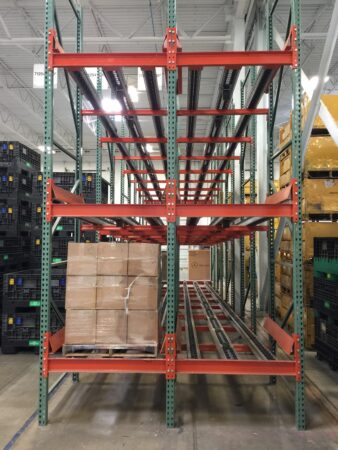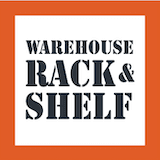Designing a pallet rack system for a warehouse requires a few basic planning steps to ensure you’ll have a safe, efficient and well-organized storage space that will be a valuable asset to your business for years to come.
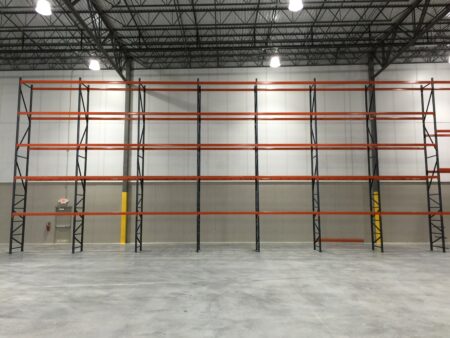
First, you’ll want to consider the type and quantity of goods you will be storing. The weight and size of the goods will determine the type of pallet rack system you need. For example, if you are storing heavy items, you will need a pallet racking system that is designed to support heavy loads.
In this early stage, you’ll want to consider the available space in your warehouse, and plan for the future needs of your business when designing the system. For example, if you expect your business to grow in the future, you should design a pallet racking system that can be expanded.
The size of the system will need to fit into the available space. You will also need to consider the aisle width and clearance height and the frequency of access. If you need to access the goods frequently, you will need a system with good visibility. You may also want to consider a system that allows for easy picking and loading like selective pallet (Picture to the right).
Then, it’s time to talk budget. The cost of the system will vary depending on the type of system, the size of the system, and the features you require. Choose a pallet rack system that’s easy to maintain and repair. This will help reduce your long-term costs.
Once you’ve considered these factors, you can begin to design your pallet rack system. Here are some steps to follow:
- Measure the available space in your warehouse. This includes the length, width, and height of the space. You should also consider the location of any doors, windows, and other obstructions.
- Determine the type of pallet rack system you need. There are many different types of pallet rack systems available, so it is important to choose one that is right for your needs. Some common types of pallet rack systems include:
- Selective pallet rack systems: These systems are the most common type of pallet rack system. They are versatile and can be used to store a variety of goods. Called selective rack because it offers great selectivity of any pallet from the aisle.
- Drive-in pallet rack systems: These systems are designed for high-density storage. They allow forklifts to drive inside the racks to access the pallets. High density, low efficiency. The lowest price high density system on the market.
- Push-back pallet rack systems: These systems are also designed for high-density storage. However, they do not allow forklifts to drive inside the racks. High density, high pick efficiency. Twice the cost of drive in but increased efficiency makes it worth it.
- Pallet flow rack systems: High density and high efficiency system. Load pallet in back of system. Pick pallet from front of system. Pallet rolls from front to back of system on flow tracks with wheels. Perfect system for first-in/first out (FIFO) pallet storage. Double the cost of pushback but if you need FIFO it’s your best choice.
- Design the layout. This includes determining the number of rows and columns of racks, as well as the aisle width and clearance height. You should also consider the location of the loading and unloading areas.
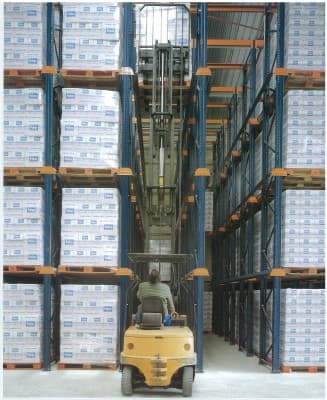
You may want to use a computer-aided design (CAD) program to create the layout of the system. This will allow you to visualize the system and make sure that it fits into the available space.
- Choose the right pallet racks and accessories. There are a variety of different racks and accessories available, so it is important to choose the ones that are right for your needs. Some common selective pallet rack accessories include:
- Wire decking: Wire decking is used to support the pallets.
- Beam guards: Beam guards protect the beams of the pallet racks from damage.
- Pallet stops: Pallet stops prevent the pallets from falling off the racks.
- Other safety accessories, such as anchors, spacers, shims, supports, and aisle protectors.
- Get your pallet rack system installed by a professional. Pallet rack systems are complex structures, so it is important to have them installed by a professional. A professional installer will ensure that the system is installed correctly and safely.
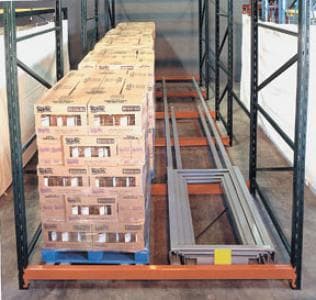
Make sure your new system is compliant with all local and federal regulations. Familiarize yourself with local building codes and safety regulations to make sure your system adheres to all the standards.
Finally, remember that safety is paramount when designing a pallet rack system, and adherence to regulations and manufacturer guidelines is essential. Proper installation and maintenance are key to a successful and safe pallet rack system in your warehouse. If you’re uncertain about any aspect of the design, consult with a professional engineer or a pallet rack system specialist to ensure safety and compliance.
Warehouse Rack & Shelf LLC can help you every step of the way from analyzing your products, analyzing your space, recommending a storage system that is right for your needs. Providing a rack layout that meets fits your space. Providing a price quotation that includes materials, freight and installation cost. We can manufacture your racks, ship your racks, install your racks and provide PE stamped drawings needed for permitting. Contact us at sales@rackandshelf.com or call 800-763-9020 to speak to one of our friendly and knowledgeable salespeople.
